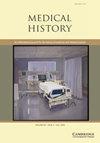Ca ' Granda,一座介于文艺复兴和现代之间的前卫医院:欧洲历史上的独特场景
IF 1.1
2区 哲学
Q4 HEALTH CARE SCIENCES & SERVICES
引用次数: 4
摘要
马焦雷医院(Ospedale Maggiore)于1456年由米兰公爵弗朗西斯科·斯福尔扎(Francesco Sforza)的遗嘱创立,在近五个世纪的时间里被认为是米兰、意大利乃至欧洲医疗保健的典范。大庄园吸引了来自欧洲各地的患者,以引进新的治疗方法和创新的医疗改革而闻名。在医院的墓地里仍然躺着死去的病人的尸体,他们来自最贫穷的人口阶层。对他们遗骸的研究旨在为他们每个人提供一个一般的身份和故事,并重建16世纪米兰人口的一部分,涉及生活方式和疾病,并检查这家特殊医院的实践和治疗。据估计,大约有200万具混合骨骼和关节骨骼与其他类型的发现(如陶瓷、硬币、衣服)一起躺在地窖里。这些遗骸是一个大型项目的对象,涉及从人文科学到硬科学的各个学科。本文的目的是将这一历史瑰宝引起学者们的注意,并提供其内容已经揭示的一瞥。本文章由计算机程序翻译,如有差异,请以英文原文为准。
Ca’ Granda, an avant-garde hospital between the Renaissance and Modern age: a unique scenario in European history
Abstract The Ospedale Maggiore, known as Ca’ Granda, was founded in 1456 by will of Francesco Sforza, Duke of Milan, and was considered for almost five centuries a model for Milanese, Italian and even European healthcare. Attracting patients from all over Europe, the Ca’ Granda distinguished itself for the introduction of new treatments and innovative health reforms. In the burial ground of the hospital still lie the bodies of the deceased patients, who came from the poorest strata of the population. The study of their remains aims to give back a general identity and a story to each of these persons as well as reconstruct a fraction of the sixteenth century population of Milano as concerns lifestyle and disease and examine practises and therapy of this exceptional hospital. It is estimated that about two million commingled bones and articulated skeletons rest in the crypt, together with other types of findings (e.g., ceramic, coins, clothing). These remains are the object of a large project involving various disciplines ranging from humanities to hard sciences. The aim of this paper is to bring this historical gem to the attention of scholars and provide a glimpse of what its contents have already revealed.
求助全文
通过发布文献求助,成功后即可免费获取论文全文。
去求助
来源期刊

Medical History
医学-科学史与科学哲学
CiteScore
1.60
自引率
0.00%
发文量
25
审稿时长
>12 weeks
期刊介绍:
Medical History is a refereed journal devoted to all aspects of the history of medicine and health, with the goal of broadening and deepening the understanding of the field, in the widest sense, by historical studies of the highest quality. It is also the journal of the European Association for the History of Medicine and Health. The membership of the Editorial Board, which includes senior members of the EAHMH, reflects the commitment to the finest international standards in refereeing of submitted papers and the reviewing of books. The journal publishes in English, but welcomes submissions from scholars for whom English is not a first language; language and copy-editing assistance will be provided wherever possible.
 求助内容:
求助内容: 应助结果提醒方式:
应助结果提醒方式:


